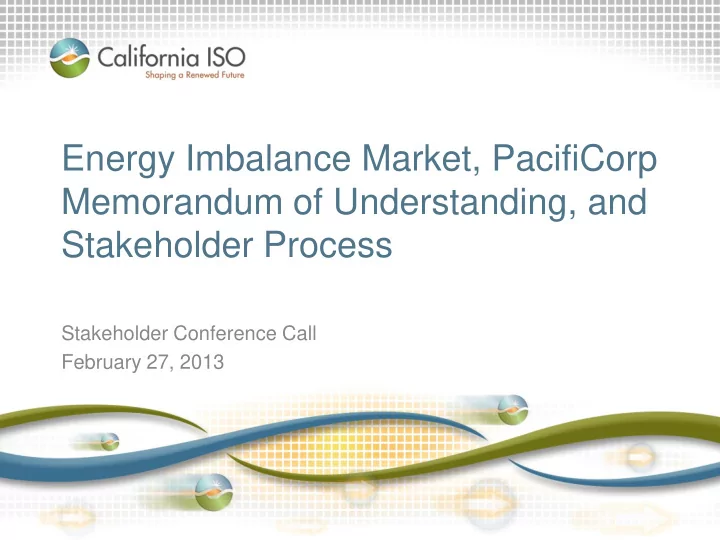

Energy Imbalance Market, PacifiCorp Memorandum of Understanding, and Stakeholder Process Stakeholder Conference Call February 27, 2013
Purpose of Today’s Meeting • Introduce the EIM Concept • Review the PacifiCorp MOU • Clarify where we are at in the process • Solicit feedback from Stakeholders • Discuss the Stakeholder Process • Identify the next steps Page 2
Agenda - 2/27/13 Time Topic Presenter 9:00 – 9:05 Introduction & Meeting Objective Tom Cuccia 9:05 – 9:35 Explain Energy Imbalance Market Don Fuller Concept 9:35 – 10:05 Review PacifiCorp Memorandum of John Anders Understanding 10:05 – 10:20 Review the Stakeholder Process Don Tretheway 10:20 – 10:30 Wrap-up & Next Steps Tom Cuccia Page 3
EIM and MOU Background • PUC-EIM group and EIM generally • ISO proposal to the PUC-EIM • Discussions with interested participants • PacifiCorp MOU • Introduce PacifiCorp Page 4
Energy imbalance market captures the benefits of the real-time market and 5-minute dispatches Day Ahead inputs Day Ahead Market Real Time • Self Schedules of • Selects least cost Operating Hour loads and resources to • Deviations or resources balance load in each imbalances occur • Bids hour • Market dispatches • Load forecast • Selects least cost resources every 5 reserves minutes to rebalance EIM Page 5
What is “imbalance” and how does EIM help • Balancing authorities (BA) start the hour with matched generation and forecasted load. • Imbalances are load and generation deviations that occur within hour. • Most BAs must procure extra reserves and dispatch manually to meet these imbalances. • Five minute dispatch: – Finds least cost resources to solve imbalance, – Avoids congestion – Dispatches them automatically Page 6
Benefits of an Energy Imbalance Market • Further enhances the ability to integrate renewable resources by dispatching every five minutes. • Provides reliability and economic benefits to all participants. – Enhances reliability through real-time visibility across all balancing authorities – Captures benefits of geographical diversity of load and resources – Balances in real-time with least cost generation Page 7
California participants and new participants benefit. • As balancing authorities join, annual benefits will accrue to both the new participant and the existing ISO participants Benefit Benefits Benefits New Existing ISO participant? participants? Reduced capacity and intra-hour reserves yes yes because of load and gen diversity, i.e. peaks and ramps at different times More efficient dispatch across balancing yes yes authorities, esp. with renewable integration More efficient 5 minute nodal dispatch yes Already benefit Page 8
ISO proposal uses existing market structure which allows for gradual expansion of the EIM. • New participants pay their way through a front end charge based on their size and ongoing charges based on their participation. • New EIM participants can join gradually, with ease of entry AND exit • ISO can leverage existing market and energy management systems Page 9
PacifiCorp Memorandum of Understanding (MOU) • Signed by CEOs Feb 12. • Non-binding commitment to proceed with EIM • Contemplates negotiation of an implementation agreement to be filed at FERC April 30. • Presentation at March 20-21 ISO Governing Board meeting, seeking approval to: – Negotiate and file implementation agreement – Initiate stakeholder process to modify tariff for EIM • Go-Live October 2014 Page 10
MOU Principles • Principles set the stage for the implementation agreement and stakeholder process • 12 principles identified in the MOU, which address: – Compatibility with existing and emerging initiatives – Support for additional market participants – Implementation costs and ongoing charges – Governance framework – EIM market rules – Compliance with mandatory standards • Pacificorp Comments Page 11
MOU Schedule • Stakeholder process milestone schedule – March 20-21 board authorization – April stakeholder process starts – Sept-Dec 2013 ISO board approval of EIM market rules – Jan-Mar 2014 file EIM tariffs with FERC – October 2014 go live • ISO-PacifiCorp project milestone schedule – Provides high level timeline for the parties Page 12
Topics to Address in Stakeholder Process • New participant application windows • What real time functionality is included? • Requirements to support the EIM • Provisions to mitigate leaning on EIM • Compliance with NERC/WECC and state requirements • EIM service agreements • EIM oversight • Other items based on Stakeholder input Page 13
ISO Stakeholder Initiative Process We Are Here Page 14
Next Steps • Board presentation March 20-21 • Launch stakeholder process in April with straw proposal and meeting • Any comments can be submitted to: – EIM@caiso.com or – Don Tretheway at 916-608-5995 • Submission to ISO Governing Board Nov 2013 • File Tariff with FERC Jan 2014 • Implementation October 2014 Page 15
Recommend
More recommend